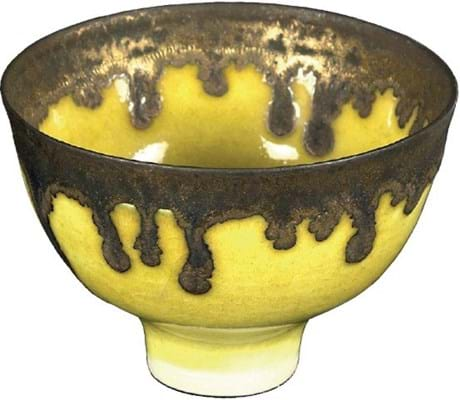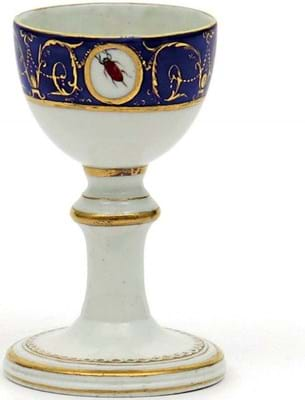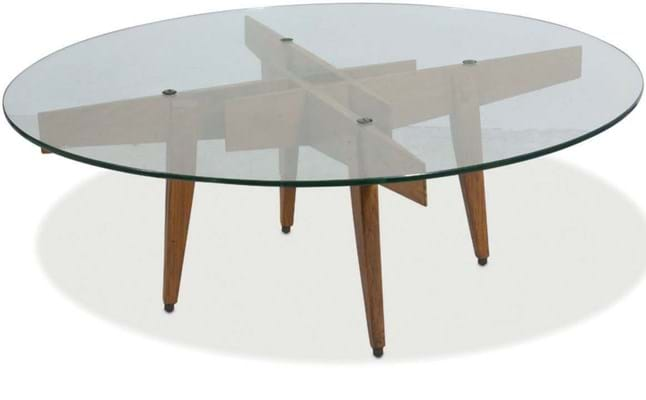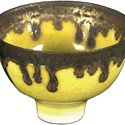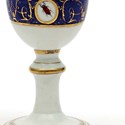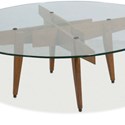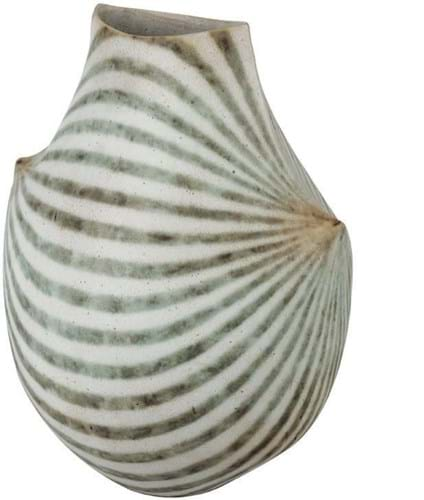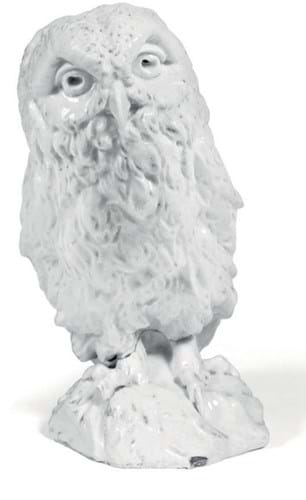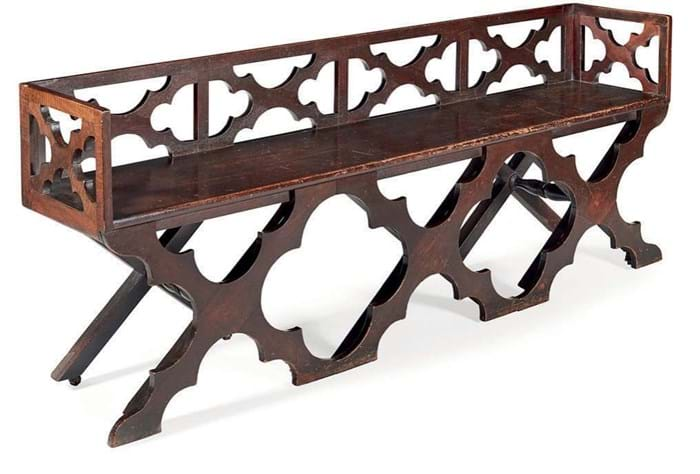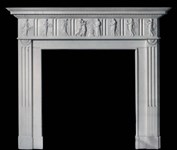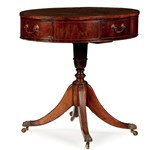Spring sales highlighted the resurgence of modern pottery, with five-figure and occasional six-figure prices for major names.
But even the enormously fashionable Lucie Rie has her ceiling price – admittedly a fairly high ceiling.
Some top-end collectors have already secured their statement pieces and all the big-spenders are demanding the flawless best.
At Chorley’s (20% buyer’s premium) sale at Prinknash Abbey on May 15, two of Dame Lucie’s archetypal footed bowls with yellow glaze and bronze manganese drip rims, both with impressed artist’s seals, went on lower estimates.
One was a 3½in (9cm) porcelain footed bowl bought for £440 from the Oxford Gallery in 1986, the other a 6¾in (17.5cm) diameter stoneware bowl bought from the Peter Dingley Gallery in 1983 for £575 in 1983.
Both were in good but not quite perfect condition, with some faint crazing, pitting and pinprick holes to the glaze.
They each went to the London trade on the lower estimates at £20,000.
The projected star, a c.1980, 6½in (16.5cm) diameter stoneware footed bowl with an emerald green glaze and manganese drip rim had been bought from the Peter Dingley Gallery in 1988 for £1350.
In similar condition to the other two, it had a tiny nick to the rim but this was commensurate to the potting rather than damage. Nevertheless, bidders baulked at the £30,000- 50,000 estimate and it did not sell.
Although there were none of John Ward’s hugely popular striped vases from the ’90s, the potter was represented by a white stoneware vessel decorated with green radiating concentric circles and a striking stoneware tailed bowl in matt black and white glaze.
They went within estimate to UK collectors at £4500 and £4200 respectively.
Ward was also well received at Chiswick Auctions (25% buyer’s premium) on April 17 with two of the striped vases, each dated c.1993 and impressed with the artist’s seal, going well above modest estimates to the same London collector.
Both with a green striped matt glaze on a white background, rather than the more favoured black and white, pieces, a 16in (40cm) high example sold at £12,000 (estimate £3500-4500). The other, 10in (245cm) tall, made £8000 against a £3500-4500 estimate.
Eighteenth century ceramics generally are considerably less fashionable but the best, and the unusual, material is always in demand.
At Lawrences (25% buyer’s premium) sale at Crewkerne on April 12, the major surprise was an 18th century delftware barber’s bowl with its distinctive crescent cutaway section.
Probably a London piece, the 10½in (26.5cm) diameter bowl decorated with chinoiserie scenes and inscribed James Innard 1758 went a Somerset collector at £6400 – 10 times the mid-estimate.
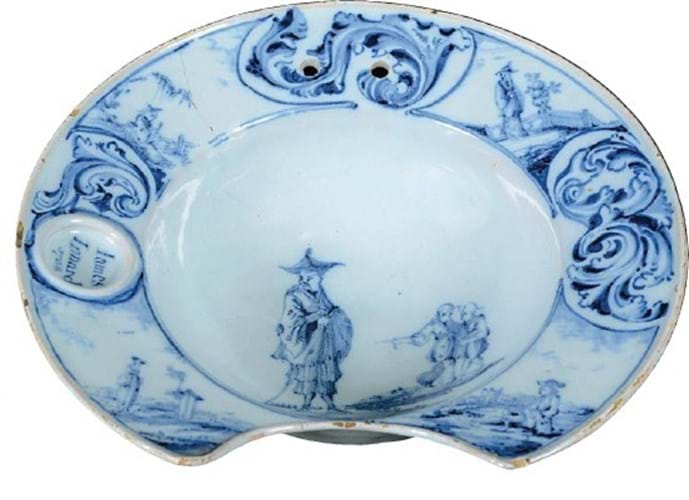
London delft barber’s bowl – £6400 at Lawrences of Crewkerne.
Also sought-after was a c.1793 Sèvres cabaret service. The teapot and two cups and saucers painted with vases and swags of flowers were on their 15¾in (40cm) wide tray marked with the letter R, red interlinked letter Ls beneath a crown, the painted year mark PP and the gilder’s mark 2000.
Estimated at £2000-3000, the service sold to the London trade at £6400.
From around half a century earlier was a Chelsea triangle period model of an owl offered at Bonhams (25% buyer’s premium) at Knightsbridge on May 2.
The c.1745-49, 8in (20.5cm) tall well-detailed bird had firing defects and some damage but, against a £4000-6000 estimate, sold at £11,000.
The stand-out piece of porcelain at Woolley & Wallis (25% buyer’s premium) at Salisbury on May 2 was an egg cup – once part of a 1603-piece service made by the Belgian soft-paste specialist Tournai factory for Philippe duc d’Orléans in 1787.
Dispersed during the French Revolution, which got under way with the storming of the Bastille two years later, today much of the service is in the Royal Collection at Windsor Castle, including 23 egg cups.
Presumably the royal family did not think another was needed, despite Prince Charles’ supposed liking for a choice of four or five boiled eggs so that he might pick one of the preferred consistency.
Spirited bidding from the Continent, however, proved sufficient to take the Salisbury offering way beyond a surprisingly modest £500-800 estimate.
The egg cup sold to a Belgian collector at £12,000.
Glass
Although qualifying as antique, Daum was among the pioneers of what we think of as modern glass and a fine example was offered at Chiswick Auctions’ April 17 sale.
Dated c.1900 and etched with the maker’s mark for Daum Nancy France, this was an acid etched cameo glass pitcher in the well-known Mushroom pattern.
The (13.5cm) tall pitcher sold at £4600 – 10 times the lower estimate.
Some 80 wine glasses from the early and mid-18th century opened Woolley & Wallis’ May 2 sale, with prices mainly in three figures.
Among the four-figure successes was a c.1770 enamelled glass on double-series opaque twist stem by Beilby which made a top-estimate £1500.
While Beilby’s name alone is guaranteed to spark interest, the enamelled tumbler at Bonhams’ May 2 sale was something special.
Dated c.1765, the beaker was one of only three recorded Beilby enamelled vessels associated with the Order of the Thistle.
It was painted with a thistle surmounted by a royal crown and inscribed in opaque white Nemo me Impune Lacessit, the royal motto in Scotland.
Established by James VII (England’s James II) in 1687, the order, like the Order of the Garter, is entirely in the monarch’s gift and comprises the monarch and 16 lords and ladies (plus some extra royal family members). Going by the date, the glass probably belonged to the 3rd Duke of Buccleuch or the 3rd Duke of Atholl, both of whom bought glassware from the Newcastle maker.
It was estimated at £10,000- 14,000 and sold at £16,000.
Furniture
As with modern ceramics, the market in modern furniture goes from strength to strength, from affordable pieces mass produced to famous designs to rarer material by iconic names that only the extremely wealthy can buy.
One of those names is the eminent Milanese architect, industrial designer and artist Gio Ponti (1891-1979). The c.1940 glass-topped ash coffee table manufactured by Giordano Chiesa offered at Chiswick Auctions in April was not in the six-figure league but highly desirable.
The 3ft 7in (1.10m) diameter table was estimated at £3000-4000 but went to the London trade at £10,000.
Back in the less heady world of antique furniture, it remains largely a case of the best and the rest, with the middle market still squeezed.
That said, it is selling again and did so at the May 2 sale at Lyon & Turnbull (25% buyer’s premium) in Edinburgh.
Two pieces from a private collection in Lancashire stood out.
One was a late 18th century breakfront library bookcase after a design by Sheraton.
Standing a hefty 8ft 6in tall x 10ft 4in wide (2.6 x 3.15m) and featuring astragal glazed doors and side doors with the top drawer to the base fitted for writing, it sold within estimate at £9000.
A fine example of the now rather out-of-fashion mahogany drum table more than doubled expectations. In the manner of Gillows, this Regency piece with 4ft 2in (1.28m) diameter top inset with tooled red leather sold at £7500.
An example of how an unusual piece of good quality can catch the eye was a late 18th-early 19th century ‘Gothick’ oak settle.
With a 5ft 10in (1.78m) long plank seat with trefoil-shaped X-form pierced panels and X-form supports, it was pitched at £1500-2500 but sold at £8200.


